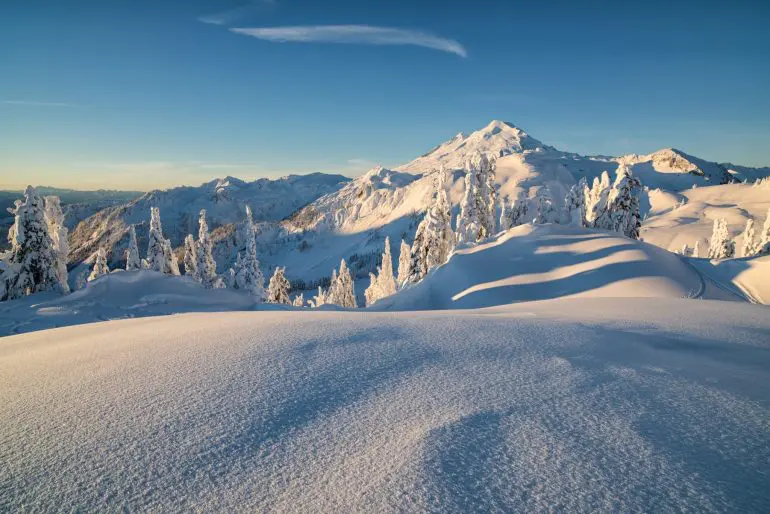It’s known as the evergreen state thanks to the forests which cover about half of its landmass, but Washington’s physiographic features are incredibly diverse. Perched high in the Pacific Northwest, the 18th largest US state can be divided into at least six regions. The centre of Washington is dominated by the relatively flat basalt plateau of the Columbia basin, while the Puget Lowlands are the most heavily populated area and home to the mysterious bumps of the mima mounds. Beyond this, there are several highland regions, from the rugged peaks and rainforests of the Olympic Mountains in the northwest to the southeastern Blue Mountains and the Coast Range. Even the Rockies make an appearance in the northeast via the Okanogan Highlands extension.
However, the highest mountains in Washington are in the Cascade Range. And it’s here that we’ll start our exploration of these top peaks.
The Cascade Range

Mount Baker and Mount Rainier in the Cascade Range (Credit: aaaaimages via Getty Images)
Extending from northern California to southern British Columbia in Canada, the Cascade Range runs through the heart of Washington State. And, while it’s famed for its high, snowy peaks, dense forests and impressive glaciers, there’s another prominent characteristic for which it is renowned: volcanism.
Vast volcanoes dominate the Cascades and thus the list of the highest mountains in Washington. And, while most are extinct, at least five of the biggest mountains of Washington state are considered potentially active. And that includes the highest of them all, Mount Rainier.
Mount Rainier

Mount Rainier reflected in the Tipsoo Lake, Washington (Credit: bradwetli photography via Getty Images)
It’s the highest mountain in Washington, the fifth highest in the contiguous United States and one of the world’s greatest volcanoes. Outside of Alaska, it has the largest glacier system of any mountain in the US. The highest peak throughout the Cascade Range, its indigenous name is Mount Tacoma, but since 1792 it has been called Mount Rainier. And it seems to embody nature’s grand scale in almost every respect.
Located within Mount Rainier National Park, this rocky behemoth climbs to 14,410 feet above sea level, the ruggedness of its vast, snowcapped cone only enhanced by the vibrant carpet of wildflowers and evergreen forests in its foothills. Its base covers roughly an area of about 100 square miles, roughly the size of Edinburgh.
A composite or “stratovolcano,” this means Rainier formed from layers of lava accumulated from eruptions. These began within the past million years, rendering it fairly young in geological terms. The last of these explosive events was about a century and a half ago, but it is still considered potentially active. In fact, the International Association of Volcanology and Chemistry of the Earth’s Interior classifies it as one of 16 “Decade Volcanoes,” which are notable for their destructive potential and proximity to populated areas. In Rainier’s case, it has the cities of Tacoma, Seattle and Portland within 40, 70, and 100 miles respectively.
Mount Adams

Trout Lake and Mt. Adams, Washington, USA. (Credit: Don Smith via Getty Images)
The second of the highest mountains in Washington was never meant to be named after the second US President. As the story goes, a cartographical mishap meant it received the name intended for Mount St. Helens, just 35 miles away. Rising to 12,280 feet, the history of Mount Adams stretches back around a half a million years. Like Rainier, it’s a potentially active stratovolcano of the Cascades. However, set within a 500-square-mile volcanic field in the Mount Adams Wilderness, its nearest city, Portland, 70 miles away, it is more remote.
Mount Baker

Mount Baker of the North Cascades, Washington. (Credit: july7th via Getty Images)
There were several indigenous names for what is now Mount Baker. The best known of these, Koma Kulshan, means the “Great White Watcher.” In addition to its evocative nature, it certainly suits this snowy-white giant. Its current name, after a Royal Naval officer, dates back to 1792. At 10,781 feet above sea level, Mount Baker is third highest of the tallest mountains in Washington and, at just 15 miles south of the Canadian Border, the state’s most northernmost volcano.
Glacier Peak

Image Lake and Glacier Peak, Washington (Credit: Alan Majchrowicz via Getty Images)
Other than Mount St Helens, no other volcano in Washington has generated such powerful eruptions in the past 15,000 years as Glacier Peak. Named for the dozen or so glaciers that line its slopes, it lies within the Glacier Peak Wilderness Area in Snohomish County. And, at 10,545 feet high, is the fourth of Washington’s highest mountains.
Mount St. Helens

Mount St. Helens, Washington. (Credit: Jesse Estes via Getty Images)
Before its catastrophic eruption on 18 May 1980, Mount St. Helens was the fifth of the highest mountains in Washington at 9,677 feet above sea level. The event removed over a thousand feet off the top of the stratovolcano, reducing its elevation to 8,363 feet. Located in Skamania County, it lies around 100 miles south of Seattle.
Bonanza Peak

Scenic view of Glacier Peak and the North Cascades. (Credit: Cavan Images / Brent Doscher via Getty Images)
Of the biggest mountains of Washington, Bonanza Peak is the tallest non-volcanic peak. With an elevation of 9,516 feet, it’s also the highest non-volcanic member of the Cascades. Set within Glacier Peak Wilderness Area, it’s located in Chelan County approximately 14 miles northeast of Glaciers Peak itself.
The Biggest Mountains of Washington

Mount Rainier at Sunset, Mount Rainier National Park, Washington. (Credit: chinaface via Getty Images)
As we’ve seen, Washington’s highest mountains are also some of its most explosive, with the top four being active stratovolcanoes. What’s more, the highest mountain in Washington is the tallest in the lower 48 states.











